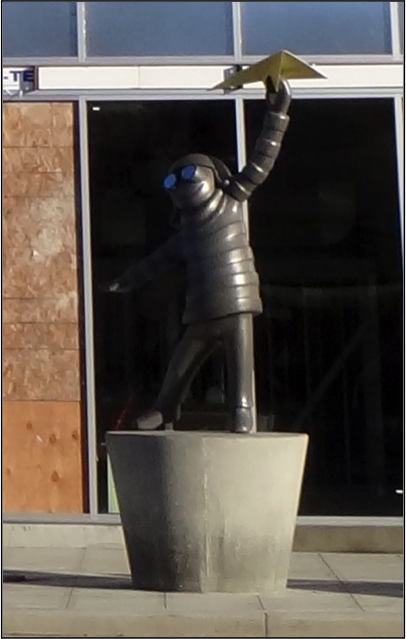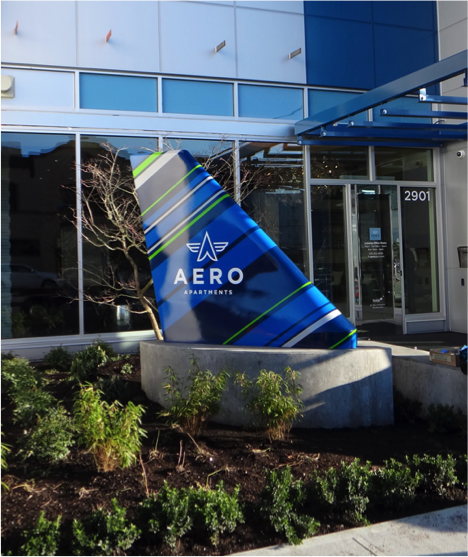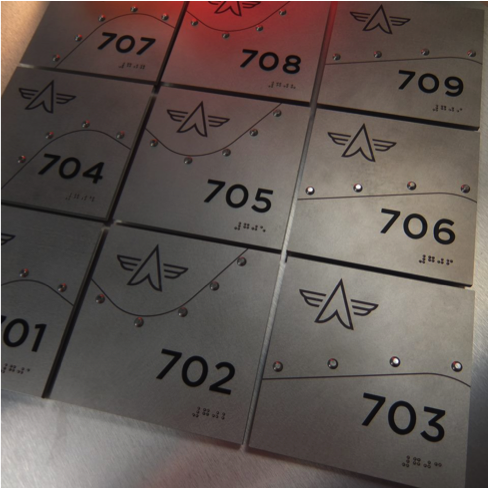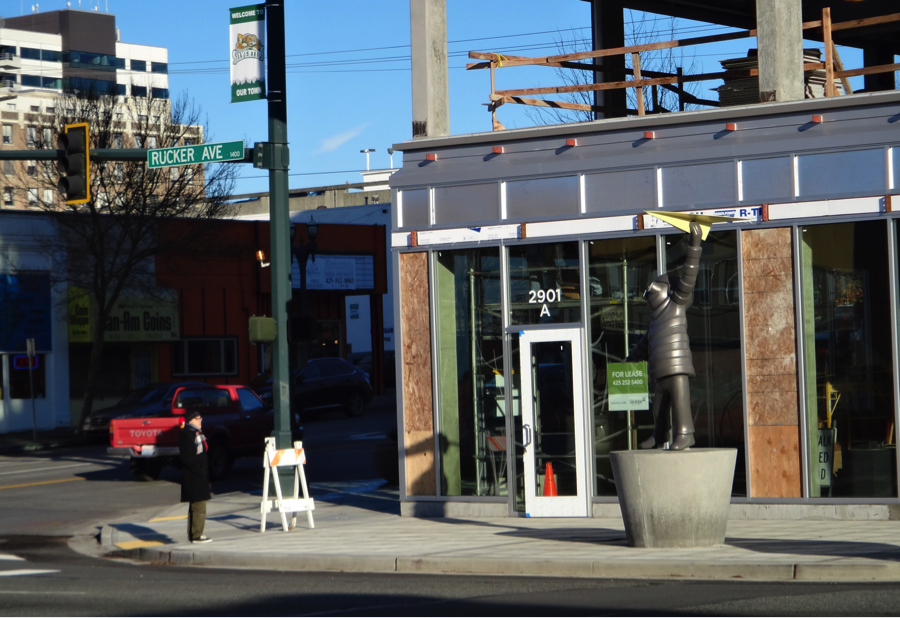
Straining for maximum reach, a child in aviator goggles and cap launches a paper airplane into the sky. “Someday” is the title of a new public art installation in front of the nearly complete Aero Apartments in downtown Everett. Someday faces to the sky west-northwesterly over Port Gardner. “Aviation is a big part of the story of Everett,” says Craig Skotdal, a member of the local family that is developing of the Aero. He continues with “the more you can make your building unique, the more it distinguishes you from the competition.” It only takes a casual understanding of Everett to see the connection between the new building, its art and the local aviation industry.
What isn’t so obvious is the that the gaze of Someday looks directly at the flight path of the Boeing Dreamlifter which delivers the 787 fuselages from Japan to final assembly at Paine Field in Everett. This insiders-only secret matters: “If we can connect people to where they live, they feel like part of the community. They are more likely to stay,” explains Skotdal as he finishes his description of how the only color on the art piece is the airplane to emphasize the dream of flight.
With 7 stories and 102 units, the Aero Apartments are testing the depth of the high-end rental market in Everett. A historically working class town, Everett is undergoing a something of a blue-collar renaissance where derelict commercial and industrial buildings are giving way to renovation and new construction that usher in an increasingly urban lifestyle. Any attempt at transition from gritty and neglected to something better is fraught with uncertainty, but art and culture are key parts of avoiding the sterile prosperity that too much of the new urban housing around Puget Sound reflects.
As noted by the Economist Intelligence Unit in its Future Cities series, major cities that are experiencing their own renaissance often have one thing in common: they “are emerging as creative forces thanks to burgeoning arts and culture sectors. Based on the collective strength of their creative industries, these cities are driving new business, spurring innovation, attracting talent and investment and, in the process, accelerating urban development and improving the overall quality of life for their residents.” Places like Austin, Texas, and Berlin, Germany, prospered during and after the great recession while other cities struggled by reinforcing their music and visual arts scenes, respectively.

On a local scale, the Skotdal family hopes that use details such as metallic elements evocative of the area’s industrial past and future to keep residents rooted to their building and city. Examples include an airplane tail section at the lobby entrance and riveted unit sign plates. Further attaching the building to the local manufacturing scene, the maker of the larger public art pieces is Dillonworks, a fabrication shop in nearby Mukilteo that has a global portfolio.
While the commercial and live-work units on the ground floor are still receiving their final touches, people have begun moving into the apartments above. According to Craig Skotdal, the building is more than 50% leased. When asked about the typical tenant, he says the “building appeals to a broad demographic. We have no need to hyper-niche” as some other building operators do. If anything, residents are adventurous urbanites that chose to live in an economically diverse city core with offerings that range from dive bars to specialized draws such as the Schack Art Center.

Many people still see Everett as a cultural backwater. It has a reputation as a worn out mill-town that has persisted for decades, despite closure last mill in 2012. Parts of the city — including the main gateways to downtown — have buildings sorely in need of maintenance. Even with this, there are signs of a growing arts culture and general prosperity in the city. Public art like that featured at the Aero Apartments is only the most visible part of the story. Locals point to the burgeoning arts and music scene, which includes venues such as The Cannery and bands like Preacher’s Wife, as evidence of a developing a north-end scene distinct from its southern neighbors in Seattle and Bellevue.
Turning a city around takes time and reputations always lag behind reality. Everett’s transition from a place with potential to somewhere that is widely seen as desirable is far from complete. Fortunately, the concept of rejuvenating a place based on a theme is a proven, if difficult, path forward as other cities in Washington State have shown. Leavenworth draws tourists with its Bavarian architecture and European-style bakeries. Snohomish turned to its early 1900’s-era architecture and many antique shops to become a magnet for day-trippers. For both cities, the process took decades to implement. If the paths taken by smaller nearby cities as well as larger cities such as Austin and Berlin are any guides, then Everett’s growing cultural offerings will become a magnet for more growth and attractions. The dream of a downtown arts district may eventually become a reality.

Waxing effusive on his favorite subject, Craig Skotdal says that “Everett is not Seattle, nor should it be. Our goal is to make Everett the best place it can be.” When asked a few years ago about a nearby building that a competitor was building, Skotdal’s complaint was that people would describe it as “good for Everett,” which would imply that it is adequate to its location but not good enough for a better city. He continues, “We want to build places that are good. Period.” Indeed.


